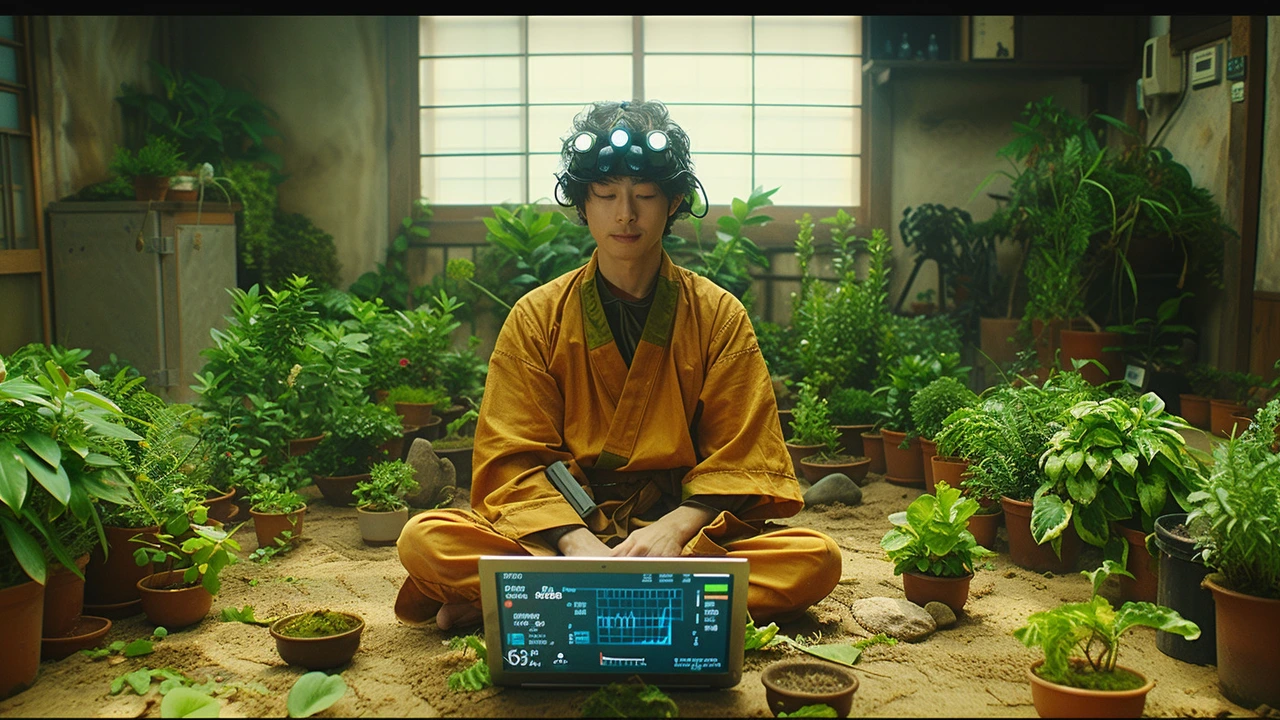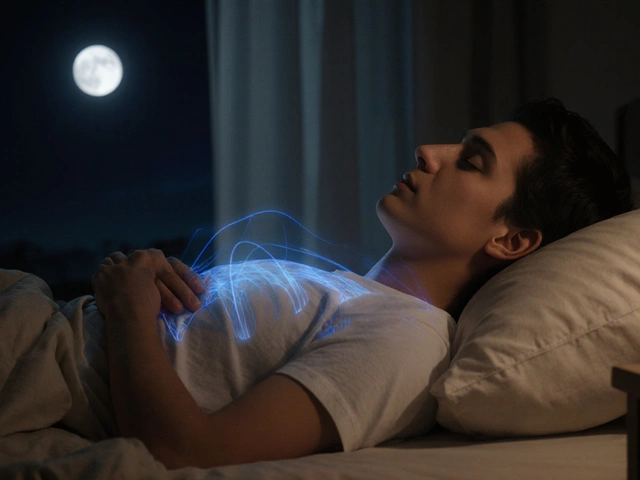Understanding the Basics of Biofeedback
In the bustling, high-tech age we live in, where smartwatches monitor our every heartbeat and sleep quality, there's another fascinating method that might have escaped your radar – biofeedback. It's a little like having a personal trainer for your mind and body, except instead of dumbbells, you're lifting the weights of self-awareness and control. Let's dive into what biofeedback is – imagine sitting comfortably in a chair, perhaps in a therapist’s office. You're connected to sensors that track your body's physiological state – heart rate, breathing, muscle tension, sweat gland activity – all the fun stuff you typically don't notice unless you're running from a bear or about to give a public speech.
Biofeedback turns the tables on the unconscious. The gist is, by getting real-time data on what's happening inside your body, you can learn to control these otherwise automatic functions. It's like a game where your body's signals are the score, and you're aiming for a high score in relaxation. Picture trying to lower your heart rate and seeing the numbers drop on a screen - that's biofeedback in action.
Apart from making you feel like a Jedi of bodily awareness, biofeedback has practical applications for a range of health issues – chronic pain, stress management, anxiety disorders, and more. And let's be honest, in the chaos of our digital lives, who wouldn't want a little extra edge in managing their body's responses?
The Diverse Types of Biofeedback Therapy
Just as there are many ways to skin a cat – which I'm certainly not endorsing, a shoutout to animal lovers and especially my golden retriever, Max – there are multiple flavors of biofeedback therapy. Each targets a different aspect of your physiological state, honing in on specific areas to master. Let's start with thermal biofeedback – it measures your skin temperature. Ever get cold hands when you're nervous? That's your body's stress response, folks. Thermal biofeedback helps you to get cozy and warm those fingertips through relaxation techniques.
Then there's muscle feedback or electromyography (EMG) for the science buffs. This one is all about your muscle activity and tension. It's great for conditions like back pain or tension headaches. Have you ever felt like your shoulders are squeezing your ears because of stress? Yeah, those muscles could use a biofeedback chill pill. Moving onto the rhythm section, we have heart rate variability (HRV) biofeedback. It's like composing a symphony with your heartbeat, trying to get different parts of the nervous system to play nicely together, which can improve heart health and reduce anxiety.
There's also electrodermal activity (EDA) biofeedback, which sounds like a dance party for electrons but actually tracks your sweat gland activity. Why? Because sweating isn't just for gyms or hot summer days; it’s a subtle signal of stress. EDA biofeedback teaches you to keep your cool, both literally and figuratively. Lastly, there's respiratory biofeedback, for those of us who forget breathing is more than just staying alive. It's about the rhythm and depth of your breaths, and it can have a massive impact on your overall well-being.
Personal Vignette: My First Encounter with Biofeedback
Okay, storytime! Once upon a time, or more accurately, a couple of years ago, I found myself dealing with the big A – anxiety. My palms were like mini waterfalls, my stomach was in knots, and let's not even mention the sleepless nights. Matthias, ever the supportive spouse, encouraged me to try countless remedies – yoga, essential oils, you name it. One day, a friend mentioned biofeedback, and I chuckled. The idea seemed as outlandish as Max doing my tax returns.
But under the "try anything once" mantra, I gave it a go. I remember sitting in the chair, sensors stuck to me, feeling like a science fiction starship was about to launch. The therapist was soothing, and as the session progressed, a curious thing happened. I could see my heart rate on the screen, zigzagging wildly, and as I employed breathing techniques, it began to smooth out like ripples on a pond settling after a stone's thrown. It was a game-changer. It wasn't just about the data, but feeling that sense of control, like I had a secret lever to my body's response mechanisms. The experience laid the groundwork for profound changes in managing my stress and anxiety. Now, it's not a cure-all, but it sure is a tool worth having in the toolbox – along with calling Matthias to deal with spiders, because that's a biofeedback challenge I'm not ready for yet.
The Science Behind Biofeedback
The science of biofeedback is not just a cool party trick; it's grounded in understanding the mind-body connection. The brain is a chatterbox, constantly sending signals to the body, and vice versa. When you're anxious or stressed, these signals can get as jumbled as a toddler's explanation of where the last cookie went. Biofeedback aims to untangle these messages, giving you insight into how your thought patterns influence your physical state.
It works by tapping into your autonomic nervous system – the behind-the-scenes maestro responsible for regulating involuntary bodily functions. Biofeedback effectively gives you backstage passes, allowing you to influence the concert of your inner workings. It's like having the cheat codes to a video game, but this game is your well-being, and the rewards are far more satisfying than any high score.
Research backs up the benefits of biofeedback. Studies have shown improvements in conditions such as hypertension, attention deficit hyperactivity disorder (ADHD), and migraines. The cool part? It's one of the few therapies out there that offers no side effects – unless you count becoming overly fascinated with the workings of your insides, or the compulsion to show off your heart rate control at parties, as side effects.
Preparing for Your First Biofeedback Session
Preparing for your first biofeedback session is like gearing up for a first date – you want to make a good impression, but also stay true to yourself. So, how do you get prepped? First, dress comfortably. This isn't the time for those fashion-forward but breathing-averse outfits. You want to wear loose-fitting clothes that won't mess with the sensors, or your ability to relax.
Next, come with an open mind. You don't need to understand the intricacies of your sympathetic nervous system any more than you need to understand the quantum mechanics of your smartphone to use it. Just be ready to learn and engage with the process. And eat beforehand! There's nothing more distracting than a grumbling stomach when you're trying to concentrate on calming your heartbeat.
Lastly, if you're someone who likes to be prepared (guilty as charged – I carry emergency snacks at all times), you might want to jot down what you hope to achieve or any particular issues you want to address. This will help your therapist tailor the session to your needs. And breathe – ironically essential for a therapy that often focuses on teaching you just that.
What to Expect During a Biofeedback Session
Once you're in the room, ready for your biofeedback journey, what unfolds? Typically, you'd be hooked up to the monitoring devices – don't worry, it's noninvasive, more like heavy-duty Velcro than anything medical drama-worthy. These sensors relay your biological data to a monitor that either you or your therapist will watch.
The therapist will guide you through the reading – deciphering the squiggles and numbers that represent your heartbeats, muscle tension, or other bodily functions being tracked. The next part is where it gets interactive – you'll perform exercises like deep breathing, progressive muscle relaxation, or guided imagery. Think peaceful beach scene, not navigating through traffic. As you practice these techniques, you'll see in real time how your body responds. Is your muscle tension decreasing? Is your skin temperature rising? It's like being in the driver's seat of a car where you’re seeing the dashboard indicators for the first time.
During this session, it's important to maintain an attitude of curiosity and patience. There's no failing in biofeedback – only learning. Changes might be subtle at first, but like any skill, it gets better with practice. And remember, laughter is the best medicine, so if you find the situation amusing – like I did, trying not to giggle as my stomach did a symphony of digestion sounds – let it out. Joy has its own positive physiological effects.
Tools and Techniques to Amplify Biofeedback
Now, if you're the type who loves gadgets, you'll be thrilled with the tools and techniques involved in biofeedback. While in-session, state-of-the-art equipment is used to gather your biological data. But what about between sessions? You'll be happy to know there are apps and devices for personal use. Whether it's a wristband that monitors heart rate or an app that guides you through relaxation exercises, the biofeedback universe has you covered.
Aside from technology, there are techniques that can amplify the effects of biofeedback. Regular practice is key – this isn't a one-hit wonder. Incorporating meditation, mindfulness, or even yoga can complement the sessions beautifully. It's about stacking those habits to create a fortress of calm. And consistency – you can't expect your biceps to bulge after one gym visit, similar to how one biofeedback session won't turn you into the Dalai Lama of stress management.
Another important aspect is applying what you learn during sessions to real-life scenarios. Next time you're in traffic, instead of cursing the sea of brake lights, it's your moment to practice that smooth breathing technique. Recognizing the triggers that upset your body's harmony and using biofeedback methods to counter them can be incredibly empowering. And celebrate the small wins – changing lifelong bodily responses isn't easy, so give yourself a high-five (or a chocolate, I won't judge) when you notice progress.
The Long-Term Benefits of Biofeedback
As wonderful as it would be to solve all our issues with a snap of our fingers a la Thanos, change, especially physiological, takes time. But the long-term benefits of regular biofeedback practice are worth the proverbial marathon. Let's start with the reduction in symptoms. Whether it's fewer migraines or a better handle on anxiety, the symptomatic benefits can be substantial. Not to mention, it can reduce reliance on medications in some instances, which is always a plus.
Then there's the aspect of self-regulation. The skills you learn through biofeedback aren't single-use. They're like a Swiss Army knife for handling life's stresses. The more you practice, the more ingrained these skills become in your daily routines, effectively rewiring your responses. It's not just about symptom relief; it's about transforming your relationship with your body and stress.
And what about prevention? Biofeedback can serve as a buffer against future stress and related conditions. Think of it as reinforcing the walls of your fortress before the siege, rather than trying to patch up holes while under attack. It fosters resilience, equipping you with tools to handle whatever life throws your way – and let's be real, life's got quite the throwing arm.
Incorporating Biofeedback into Daily Life
So, how do you take what you learn in the calm oasis of a biofeedback session and translate it to the beautifully messy tapestry of daily life? It starts with mindfulness – paying attention to your body's signals. Is your jaw clenched while you work? Are your shoulders creeping towards your ears during a stressful phone call? Recognizing these signs gives you the cue to employ biofeedback techniques.
Practice makes perfect, or at least better. Just like playing an instrument, the more you practice biofeedback techniques, the more proficient you become. Set aside time daily to practice the breathing or relaxation strategies you’ve learned. And involve your loved ones! Matthias and I have breathing sessions together, which is both bonding and beneficial – plus, it's hard to get worked up about whose turn it is to do the dishes when you're both zen-ed out.
While it's not always possible to strap on sensors throughout the day, modern tech does offer a helping hand. Wearable devices can remind you to breathe deeply or alert you to increased tension levels. And remember, small opportunities for practice are everywhere – whether it's while brewing coffee, waiting in line, or being on hold with customer service (a personal favorite).
Conclusion: Embracing the Biofeedback Journey
Embarking on the biofeedback journey is a commitment to yourself. It's about taking the reins of your mind-body connection and learning to steer through life's tumultuous waters with a bit more grace. Will there be days when it feels like two steps forward, one step back? Absolutely. But it's those times, when you persevere, that the magic happens. Just like that first session where I saw my own power reflected in the calming waves of a heartbeat on a monitor, each small victory is a testament to your ability to grow and adapt.
Perhaps one of the most beautiful things about biofeedback is the sense of empowerment it provides. You're not passively waiting for someone to fix you; you're actively engaging in the process of healing and betterment. It puts you in the driver's seat of your health, with a dashboard full of fascinating data to guide you. And isn't that what we're all seeking in one way or another? To feel like captains of our own ships on the great sea of life – with our trusty first mates and furry companions by our sides. So take heart, stay curious, and breathe deeply – your biofeedback adventure awaits.





